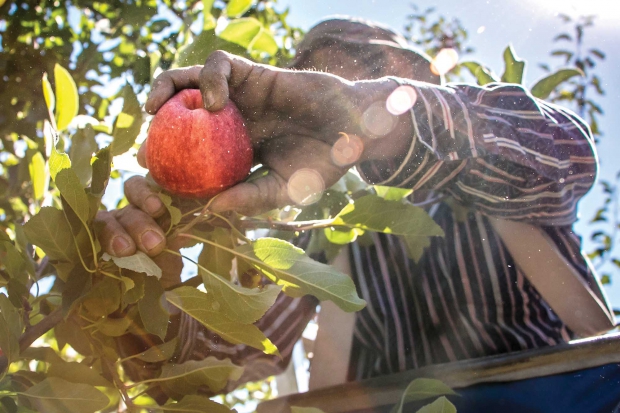
Efrain Leyva harvests Gala apples in Gleed, Washington on September 5, 2014. This year’s apple crop is expected to be the third largest ever in the United States. (TJ Mullinax/Good Fruit Grower)
U.S. apple production only amounts to about 6 percent of world production. China’s 2014 apple crop is expected to top 40 million metric tons for the first time at 41 million tons, which is more than 2 billion bushels and some 54 percent of world production.
Michael Choi, president of Zhonglu America Corporation, a wholly owned U.S. subsidiary of Zhonglu Fruit Juice Company, gave the estimate during the U.S. Apple Association’s Outlook and Marketing Conference in Chicago in August.
Choi said the Chinese eat 83 percent of their apples fresh. They import very few apples, but they like American Red Delicious, which are favored as gifts because of their shape and color.
They like sweet apples and grow mainly Fuji, but are planting more Gala. Because the Fuji and Gala crops in China are short this year, Choi said, growers are managing more of their processing blocks for fresh market, and he expects export of apple juice concentrate will follow the declining trend it has been on for a few years now.
He thinks China will sell more apples to Russia, which has banned imports from the United States and Europe in retaliation against trade sanctions designed to punish Russia for its activities in Ukraine.
Europe
Philippe Binard, secretary general of the World Apple and Pear Association based in Brussels, Belgium, said the European crop is about 12 percent above average, at 12 million metric tons, or 624 million bushels. About 30 percent of the crop is grown in Poland.
The Polish crop is expected to be 3.5 million metric tons (186 million bushels), up 13 percent and its largest crop in decades.
Canada
Donald Werden, who manages sales and logistics for the Norfolk Fruit Growers Association in Simcoe, Ontario, estimated the Canadian apple crop at 22 million bushels, slightly larger than last year and the largest crop since 2007.
Breaking it down by province, he put the Ontario crop at 9 million bushels, which is down 6 percent from last year. Ontario produces about half of Canada’s apples.
The British Columbia crop he estimated at 4.5 million bushels, up 16 percent from last year.
Quebec production is down 2.5 percent to 6 million bushels. Nova Scotia growers suffered a massive fire blight infection this year, as foliage was damaged by Hurricane Arthur on July 4, and some fruit bruising may have resulted from that. The crop is expected to be up 6 percent to just over 2 million bushels. New Brunswick will contribute 170,000 bushels.
Canadian growers, always heavy on McIntosh and related varieties, are changing over to modern varieties like Honeycrisp, Ambrosia, and Gala, and to high density plantings. Interestingly, however, Ontario’s top variety this year will be Northern Spy.
Mexico
Production in Mexico last year was a record “and a major disaster,” according to Leighton Romney, CEO of Paquime Group in Chihuahua, Mexico. The group produces, imports, and distributes apples, peaches, and other fruits.
The 2013 crop of 24.5 million bushels, 50 percent larger than normal, was met with a shortage of labor, bins, and controlled-atmosphere storage space, Romney said, and poor quality apples were being marketed from common storage late in the marketing season.
Prices are low now, he said, but he expects them to recover by November when the smaller 2014 crop comes to market. He estimated the crop size at 16 million bushels.
South America
Rene Alarcon, South American manager of Carlos Steffens, Inc., a brokerage company located in Santiago, Chile, reported that freezes cut this year’s South American production to 695,000 metric tons (36.5 million bushels) in Argentina, 1.2 million metric tons (64 million bushels) in Brazil, and 1.6 million metric tons (84 million bushels) in Chile, he said.
South American growers export to markets all over the world. Only Chile sends a significant share to the United States.
“South American growers will likely send more apples to Russia,” he said, but that would be from the next crop that will be harvested in March 2015 and not from the 2014 crop. •
——-
Editors note: This is an update to our earlier story published online on August 28, 2014.






Leave A Comment